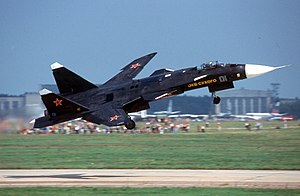Vi-84
This article is incomplete because it is pending further input from participants, or it is a work-in-progress by one author. Please comment on this article's talk page to share your input, comments and questions. Note: To contribute to this article, you may need to seek help from the author(s) of this page. |
| Viborn Vi-84 | |
|---|---|
 Vi-84 demonstrator taking off | |
| General information | |
| Type | Figher Multirole |
| Manufacturer | Viborn Aeronautics |
| Status | In service |
| History | |
| Manufactured | 1994 - present |
| Introduction date | 1st of March 1996 with Libriran Military Air Service |
Vi-84 'Lance'
The Viborn Vi-84 'Lance' is the designation for a family of single seat, twin engined 4th generation fighter aircraft built and operated for the Libriran Military Air Service. Designed to the MAS' FF-94 design competition the aircraft won out against the much cheaper PA-554, thanks to its superior agility, advanced engines, and other avionics features. However, problems persisted as it was adopted, and with early versions of the aircraft, leading to the PA-554 being adopted alongside it to serve as a stop-gap. Viborn Aeronautics eventually ironed out these problems and transformed the type into a succesful and effective aircraft, popular with its pilots and unique in that it is the first widely adopted reverse-swept wing fighter adopted in the world.
The aircraft is designed to be supersonic, with a high degree of agility in all flight regimens. Originally intended to be a pure air-superiority fighter, it has been adapted over the years to carry a plethora of ground attack weapons, allowing it to fill a limited close air support role, with its cannon, and a mixture of guided missiles and bombs.
Design
Development
The original concept for the Vi-84 began in the 1940s. Early concepts in swept and reverse swept-wing aircraft, showed promise but were limited by the material science of their day. Vladislav Viborn had a personal interest in reverse swept-wing aircraft, after his early Vi-50, and Vi-61 failed to get off the ground, (in one case literally). he developed this idea further as a private project. The advent of fly-by-wire technology and advanced composite materials in the 1980s offered a potential solution to the limitations of earlier designs. He continued the project further and submitted it as a possible combat aircraft as a late entry into the FF-94 competition, competing against another Viborn design the Vi-82.
The Vi-84 wowed the officers at the competition with a display of its incredible maneuverability, being able to perform a cobra maneuver. The various advanced features and high performance of the aircraft made it the winner, although Viborn had only brought a single aircraft with them, and that aircraft had required the use of several untried production techniques. Several features also needed to be added to have the aircraft adopted, such as radar, weapons bays, and various avionics features.